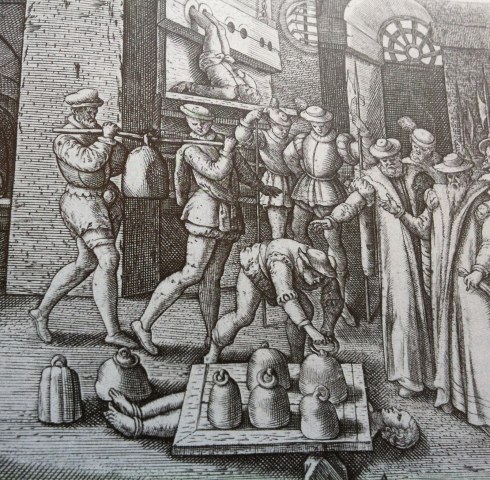Salem Witch Trials
After his arrest, Giles Corey remained in jail
with his wife until his trial on September 16, 1692. He went to the tri al
and plead "not guilty" but simultaneously refused to "put himself on the
court" because of his contempt for the court. Giles Corey was not willing to
submit himself to the jurisdiction of a court that had already determined
his guilt. Because the court had believed the testimony of the same accus
al
and plead "not guilty" but simultaneously refused to "put himself on the
court" because of his contempt for the court. Giles Corey was not willing to
submit himself to the jurisdiction of a court that had already determined
his guilt. Because the court had believed the testimony of the same accus ers
in a trial on September 9, Giles understood that there was no chance of
being found not guilty and that a conviction would be inevitable. In every
previous trial when an accused individual had plead not guilty, not a single
person was cleared so Giles preferred to undergo "what Death they would put
him to" rather than be found guilty of witchcraft and thus put to death.
According to Blackstone's three tenets, Giles was ruled as "standing mute"
because he would not be tried by "God and my country." The Court of Oyer and
Terminer strictly adhered to the requirement that a defendant "put himself
on the country". Because Giles stood mute, he was given the dreaded sentence
of peine forte et dure even though it had been determined to be illegal by
the government of Massachusetts. It was illegal for two reasons: there was
no law permitting pressing, and it violated the provisions of the Body of
Liberties regarding the end of cruel punishments. In the entire history
of the United States, Giles Corey is the only person ever to be pressed to
death by order of a court.
ers
in a trial on September 9, Giles understood that there was no chance of
being found not guilty and that a conviction would be inevitable. In every
previous trial when an accused individual had plead not guilty, not a single
person was cleared so Giles preferred to undergo "what Death they would put
him to" rather than be found guilty of witchcraft and thus put to death.
According to Blackstone's three tenets, Giles was ruled as "standing mute"
because he would not be tried by "God and my country." The Court of Oyer and
Terminer strictly adhered to the requirement that a defendant "put himself
on the country". Because Giles stood mute, he was given the dreaded sentence
of peine forte et dure even though it had been determined to be illegal by
the government of Massachusetts. It was illegal for two reasons: there was
no law permitting pressing, and it violated the provisions of the Body of
Liberties regarding the end of cruel punishments. In the entire history
of the United States, Giles Corey is the only person ever to be pressed to
death by order of a court.